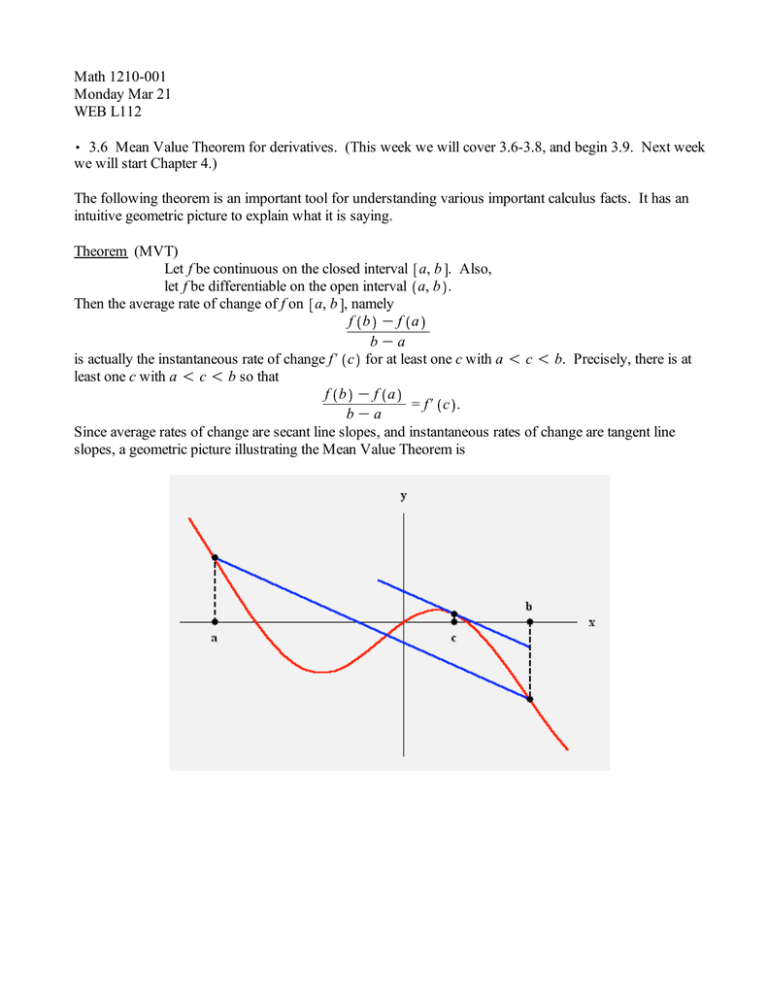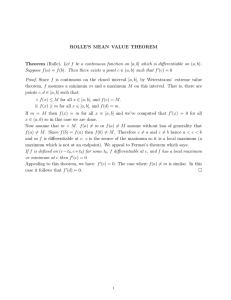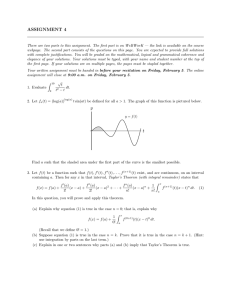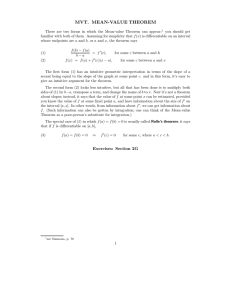Math 1210-001 Monday Mar 21 WEB L112
advertisement

Math 1210-001 Monday Mar 21 WEB L112 , 3.6 Mean Value Theorem for derivatives. (This week we will cover 3.6-3.8, and begin 3.9. Next week we will start Chapter 4.) The following theorem is an important tool for understanding various important calculus facts. It has an intuitive geometric picture to explain what it is saying. Theorem (MVT) Let f be continuous on the closed interval a, b . Also, let f be differentiable on the open interval a, b . Then the average rate of change of f on a, b , namely f b Kf a bKa is actually the instantaneous rate of change f# c for at least one c with a ! c ! b. Precisely, there is at least one c with a ! c ! b so that f b Kf a = f# c . bKa Since average rates of change are secant line slopes, and instantaneous rates of change are tangent line slopes, a geometric picture illustrating the Mean Value Theorem is The reason the MVT is true has to do with the extreme value theorem that we've been using through Chapter 3, namely that a continous function on a closed bounded interval has maximum and minimum values, and that these occur either at the endpoints or at stationary or singular points. Let's work through this: Compare f x to the secant line function through the points a, f a , b, f b on the graph of f. Via point-slope formula the secant line has equation f b Kf a yKf a = xKa bKa f b Kf a y=f a C xKa . bKa So the secant line is the graph of the function f b Kf a g x =f a C xKa . bKa Now consider h x = f x K g x . Note that , h is continuous on a, b since we are assuming f is, and we know that g is. , h is differentiable on the open interval a, b , since f, g are. , h a = h b = 0 (since g a = f a , g b = f b . Exercise 1) Draw a sketch of what the graph of h would be for the picture on the previous page. Sketch the graph of h onto that picture, because we'll refer to it below. Now consider the extreme values of h. There are two possibilities: (i) If both extreme values occur at endpoints, then both the the maximum and minimum values of h are zero since h a = h b = 0. So h x = 0 for all x on the interval, so f was actually a line function (f = g with derivative=slope everywhere equal to the secant line slope. So any c with a ! c ! b will verify the conclusion of the MVT. (ii) Otherwise there is either a positive maximum value for h x at a stationary point c, with a ! c ! b, or a negative minimum value at a (different) stationary point c with a ! c ! b (or both). In either case f b Kf a h# c = 0 0 f# c K g# c = 0 0 f# c K =0 bKa f b Kf a 0 f# c = . □ bKa In practice we'll use the Mean Value Theorem to understand other facts, and won't care about actually finding c. But here are some concrete examples that work with the hypotheses and result. In some of them we do find actual c values. Exercise 2) Pretend the highway patrol has timed you remotely on a 45 mile stretch of I 15, and it only took you half an hour to travel the distance. Can you effectively claim you were never speeding? Exercise 3) Let f x = x2 C 3 x K 6, a, b = 0, 4 . Find the average rate of change of f and verify the MVT. 20 15 10 5 0 K5 1 2 x 3 4 Exercise 4) Let f x = x3 K x2 K x C 1, a, b = K1, 2 . Find the average rate of change of f and verify 1C 7 1K 7 the MVT. (Hint: z 1.22, zK0.55. 3 3 3 2 1 K1 0 1 x 2 Exercise 5) What goes wrong with the MVT hypotheses and conclusion in the following example? f x = x , a, b = K2, 4 . 4 1 K2 K1 0 1 x 2 3 4 Applications of the MVT: 1) To section 3.2 about increasing/decreasing theorem: Theorem: Let f be continuous on a, b and differentiable on a, b with f# x O 0 for all a ! x ! b. Then f is increasing on a, b . In other words, a % a1 ! b1 % c 0 f a1 ! f b1 . Back in section 3.2 we just sort of believed this because of geometric reasoning....Here's the algebraic proof: Apply the mean value theorem to the interval a1 , b1 : f b1 K f a1 = f# c O 0 b1 K a1 0 f b1 K f a1 = f# c b1 K a1 = C $ C O 0 0 f b1 O f a1 □ (The analogous theorem for functions with negative derivatives being decreasing functions holds by similar reasoning.) 2) To upcoming material: Theorem: Let h x be continous on a, b and differentiable on a, b . Suppose h# x = 0 for all a ! x ! b. Then h x must be a constant function, h x = h a for all x in a, b . proof: Let a ! x % b. Apply the mean value theorem on the interval a, x : h x Kh a = h# c = 0 xKa 0h x Kh a = 0 0 h x = h a . □ Exercise 6) Find all functions F x for which F# x = x2 . (This is an example of what's called "antidifferentiation", section 3.8. It will be very important.)





